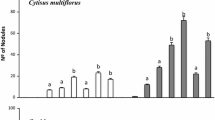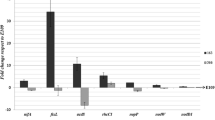Summary
-
1.
Nodule structure was examined in the red clover cultivar S123 and in lines (designated H2) separately bred for high yield withRhizobium trifolii strains RCR 0403 and RCR 5. Plants were grown at 16/11, 22/17 and 27/22°C in a 16 h day at 25,000 lux.
-
2.
The larger yields of bred lines compared with S123 were directly correlated with larger aggregate nodule size, larger infected zones and with more bacteroid tissue. Over all treatments the correlation of plant dry weight with aggregate areas of bacteroid tissue, assessed in median longitudinal section, accounted for 79% of the variance.
-
3.
Yields were unrelated to the proportion of uninfected cells and vacuoles within the bacteroid zone.
-
4.
Effects of host type and strain on nodule structure and yield were greatest at the moderate temperature and least and most irregular at high temperature.
-
5.
Bacteriod tissue degenerated more rapidly in S123 than in the bred lines, more rapidly with RCR 0403 than RCR 5 and more rapidly at the high temperature than at moderate or low temperatures.
-
6.
Aggregate nodule size irrespective of treatment was correlated with the aggregate sizes of nodule meristem and differentiating tissues. Nodule comtex comprised a larger proportion of the nodule section at 17 days than subsequently. Other than as specified above, the size relationships of the different tissues of the nodule were unaffected by host selection, temperature, bacterial strain or plant age.
-
7.
At 22/17°C over a 17–25 day period the increment in dry matter per mm2 active nodule tissue was similar for H2 and S123 plants and was less for RCR 0403 (3.33 mg) than for RCR 5 (6.87 mg). At 27/22°C the effeciency of bacteroid tissue was much less,viz. 0.67 and 1.23 mg per mm2 respectively.
-
8.
Nodule tissue areas and volumes were closely related so that unit volumes of active bacteriod tissue in general promoted similar dry matter increment in S123 and bred lines,viz. about 50.5 mg mm−3 at 22/17° for RCR 0403 and 80.8 mg mm−3 for RCR 5. The latter was associated with a fixation rate of 0.157 mg N mm−3 active tissue day−1.
Similar content being viewed by others
References
Bethlenfalvay, G. J. and Phillips, D. A. 1977 Effect of light intensity on efficiency of carbondioxide and nitrogen reduction inPisum sativum L. Plant Physiol.60, 868–871.
Chen, H. K. and Thornton, H. G. 1940 The structure of ‘ineffective’ nodules and its influence in nitrogen fixation. Proc. Roy. Soc. B.128, 208–229.
Hardy, R. W. F. and Havelka, U. K. 1976 Photosynthate as a major factor limiting nitrogen fixation by field-grown legumes with emphasis on soybeans.In Symbiotic Nitrogen Fixation in Plants. IBP Synthesis Vol. 7 Ed. P. S. Nutman. Cambridge University Press, London. pp 421–439.
Holl, F. B. 1973 A nodulating strain of Pisum unable to fix nitrogen . Plant Physiol.51, suppl.35.
Hosoda, K., Lee, K. and Yatazawa, M. 1980 Effect of carbon-dioxide oxygen and light on nitrogen-fixing activities in Japan clover (Kummerowia stricta S.) Soil Sci. Plant Nutr24, 113–119.
Jackson, W. A. and Coleman, N. T. 1959 Fixation of carbon-dioxide by plant roots through phosphoenolpyruvate carboxylase. Plant and Soil11, 1–16.
Lawn, R. J. and Brun, W. A. 1974 Symbiotic nitrogen fixation in soybeans. I. Effect of photosynthetic source-link relationships. Crop Sci.14, 11–16.
Mulder, E. G. and van Veen, W. L. 1960. Effect of pH and organic compounds on nitrogen fixation in red clover. Plant and Soil13, 91–113.
Mulder, E. G. and van Veen, W. L. 1960 The influence of carbon-dioxide on symbiotic nitrogen fixation. Plant and Soil13, 265–278.
Nutman, P. S. 1980 Adaptation.In Nitrogen Fixation. Proc. Phytochem. Soc.18, Eds. W. D. P. Stewart and J. R. Gallon, Academic Press, London (In press).
Nutman, P. S. 1981 Hereditary host factors affecting nodulation and nitrogen fixation, Proc. 4th International Conference on Dinitrogen Fixation, Canberra, pp 194–204.
Nutman, P. S. and Riley, J. 1981 Breeding of nodulated red clover (Trifolium pratense L.) for high yield. Ann. Appl. Biol. (In press).
Pankhurst, C. E. and Gibson, A. H. 1973 Rhizobium strain influences on distruption of clover nodule development at high root temperature. J. Gen. Microbiol.74, 219–231.
Pate, J. S. 1977 Functional biology of dinitrogen fixation by legumes.In A Treatise on Dinitrogen Fixation. Eds. R. W. F. Hardy and W. S. Silver. Sect. III, 473–517, Wiley, New York.
Roughley, R. J. 1970 The influence of root temperature, Rhizobium strain and host selection on the structure and nitrogen-fixing effeciency of the root nodules ofTrifolium subterraneum. Ann. Bot.34, 631–646.
Vance, C. P., Johnson, L. E. B., Halvorsen, A. N., Heichel, G. H. and Barnes, D. K. 1980 Histological and ultrastructural observations ofMedicago sativa root nodule senescence after foliage removal. Can. J. Bot.58, 295–309.
Wahua, T. A. T. and Miller, D. A. 1978 Effects of shading on N2-fixation, yield and plant competition of field-grown soybeans. Agron. J.70, 387–392.
Author information
Authors and Affiliations
Rights and permissions
About this article
Cite this article
Roughley, R.J., Nutman, P.S. & Chandler, M.R. Effect of host plant selection and temperature on the structure of root nodules of red clover (Trifolium pratense L.). Plant Soil 61, 113–124 (1981). https://doi.org/10.1007/BF02277368
Received:
Issue Date:
DOI: https://doi.org/10.1007/BF02277368




